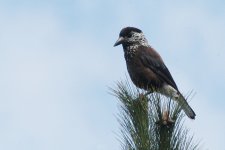Richard Klim
-------------------------
Dohms & Burg (in press). Limited geographic genetic structure detected in a widespread Palearctic corvid, Nucifraga caryocatactes. PeerJ. [abstract] [pdf]
It's a pity that no representatives of the southern hemispila group (or multipunctata) were sampled.
Madge 2009 (HBW 14):
[Large-spotted/Kashmir Nutcracker N (c) multipunctata is recognised as a distinct species by Rasmussen & Anderton 2005/2012, HBW, IOC and eBird/Clements.]
It's a pity that no representatives of the southern hemispila group (or multipunctata) were sampled.
Madge 2009 (HBW 14):
[Large-spotted/Kashmir Nutcracker N (c) multipunctata is recognised as a distinct species by Rasmussen & Anderton 2005/2012, HBW, IOC and eBird/Clements.]






